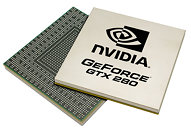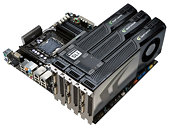Monday, June 16th 2008

NVIDIA GeForce GTX 260 and GeForce GTX 280 Announced
NVIDIA, the leader in visual computing technologies, today introduced its new family of GeForce GTX 200 graphics processors (GPUs) - which includes the GeForce GTX 280 and GeForce GTX 260 GPUs - taking graphics beyond gaming and gaming beyond anything that's ever been possible before on a consumer computing platform."The advances NVIDIA continues to make in visual computing are simply incredible, and we are excited to be one of the first companies in the world to offer the technology in the new Exhilaration Edition of the award-winning HP Blackbird 002," said Rahul Sood, chief technology officer, HP Voodoo Business Unit. "Exceptional graphics quality and performance is important to our customers, and now the GeForce GTX 200 GPUs are bringing something else into the mix. By using the GPU to enhance everyday applications such as video encoding and manipulating photos, HP Blackbird 002 is one of the most cutting-edge PC platforms ever designed."
Graphics Beyond Gaming
One of the most powerful processors in the PC is the GPU. Rendering 3D images in real-time is just about the most mathematically intensive task your PC will ever undertake, but it's not the only one. As PC applications become increasingly visual, many ordinary tasks will benefit from the graphics horsepower provided by the GPU, including encoding and playing high-definition videos, editing photos, getting driving directions off the Internet, or simply running a new operating system like Windows Vista.
"Millions of users around the world know how time consuming it is to convert their home videos for use on video sharing sites such as YouTube or for downloading to popular media players such as the iPod," said Sam Blackman, CEO of Elemental Technologies. "Elemental has developed the BadaBOOM Media Converter, a consumer video application scheduled for release in August. By taking advantage of the massively parallel, general-purpose computing architecture of a GeForce GPU, we are able to transcode high-quality video 18 times faster than with CPU-only implementations. This unprecedented performance scaling is the reason why we have made sure that our RapiHDTM Video Platform takes advantage of NVIDIA GPUs."
By recognizing that the value of a GPU transcends gaming, an increasing number of applications are also being written that use the GPU for straight, non-graphical computational tasks. For example, Stanford University's distributed computing computational program Folding@Home, combines the computing horsepower of millions of consumer GPUs to simulate protein folding to help find cures for diseases such as Alzheimer's or Parkinson's. With the computing processing power of the GeForce GTX family, applications such as Folding@Home and others can run upwards of 140 times faster on an NVIDIA general-purpose parallel processor than on some of today's traditional CPUs.
"GeForce GPUs will soon deliver the biggest boost in processing power we've seen in the history of Folding@Home," said Vijay Pande, Associate Professor of Chemistry, Stanford University. "The GeForce GTX 280 GPU runs Folding@Home 45 times faster than the latest 3GHz Core2 Quad CPU. If just one percent of the world's GeForce 8- and 9-Series GPUs ran Folding@Home, we would have 70 petaflops of processing power to help find cures for disease. That's 10 times more processing power than the world's top 100 supercomputers combined."
Gaming That's Beyond
The CUDA general-purpose parallel processing mode will usher in a new generation of ultra realistic games. Developers can use the supercomputing power of the "CUDA Computing" mode to simulate realistic, physically accurate effects then render beautiful images using the "GeForce GPU" mode. NVIDIA GPUs are also the only ones to support PhysX technology, the world's most pervasive physics engine that is already delivering dynamic 3D realism to more than 140 games across multiple platforms, and is being used by more than 25,000 developers worldwide. With PhysX, developers can incorporate effects such as rigid body dynamics, collision detection, and cloth simulation that dramatically change the way the games are played and how the on-screen stories unfold, and then accelerate those effects using the processing power of the GPU.
"I haven't been this excited about a new gaming technology in years," said Chris Taylor, CEO and founder of Gas Powered Games. "We're focusing all of our physics efforts on PhysX, and it already delivers the kinds of advanced effects in Space Siege that takes the whole experience to the next level. And in the near-future, you're going to see real-time, Hollywood cinematic-level environmental effects on GPUs like the GeForce GTX 280. We're talking about some wicked-cool technology here!"
Additional features of the GeForce GTX 280 and GeForce GTX 260 GPUs include:
Source:
NVIDIA
Graphics Beyond Gaming
One of the most powerful processors in the PC is the GPU. Rendering 3D images in real-time is just about the most mathematically intensive task your PC will ever undertake, but it's not the only one. As PC applications become increasingly visual, many ordinary tasks will benefit from the graphics horsepower provided by the GPU, including encoding and playing high-definition videos, editing photos, getting driving directions off the Internet, or simply running a new operating system like Windows Vista.
"Millions of users around the world know how time consuming it is to convert their home videos for use on video sharing sites such as YouTube or for downloading to popular media players such as the iPod," said Sam Blackman, CEO of Elemental Technologies. "Elemental has developed the BadaBOOM Media Converter, a consumer video application scheduled for release in August. By taking advantage of the massively parallel, general-purpose computing architecture of a GeForce GPU, we are able to transcode high-quality video 18 times faster than with CPU-only implementations. This unprecedented performance scaling is the reason why we have made sure that our RapiHDTM Video Platform takes advantage of NVIDIA GPUs."
By recognizing that the value of a GPU transcends gaming, an increasing number of applications are also being written that use the GPU for straight, non-graphical computational tasks. For example, Stanford University's distributed computing computational program Folding@Home, combines the computing horsepower of millions of consumer GPUs to simulate protein folding to help find cures for diseases such as Alzheimer's or Parkinson's. With the computing processing power of the GeForce GTX family, applications such as Folding@Home and others can run upwards of 140 times faster on an NVIDIA general-purpose parallel processor than on some of today's traditional CPUs.
"GeForce GPUs will soon deliver the biggest boost in processing power we've seen in the history of Folding@Home," said Vijay Pande, Associate Professor of Chemistry, Stanford University. "The GeForce GTX 280 GPU runs Folding@Home 45 times faster than the latest 3GHz Core2 Quad CPU. If just one percent of the world's GeForce 8- and 9-Series GPUs ran Folding@Home, we would have 70 petaflops of processing power to help find cures for disease. That's 10 times more processing power than the world's top 100 supercomputers combined."
Gaming That's Beyond
The CUDA general-purpose parallel processing mode will usher in a new generation of ultra realistic games. Developers can use the supercomputing power of the "CUDA Computing" mode to simulate realistic, physically accurate effects then render beautiful images using the "GeForce GPU" mode. NVIDIA GPUs are also the only ones to support PhysX technology, the world's most pervasive physics engine that is already delivering dynamic 3D realism to more than 140 games across multiple platforms, and is being used by more than 25,000 developers worldwide. With PhysX, developers can incorporate effects such as rigid body dynamics, collision detection, and cloth simulation that dramatically change the way the games are played and how the on-screen stories unfold, and then accelerate those effects using the processing power of the GPU.
"I haven't been this excited about a new gaming technology in years," said Chris Taylor, CEO and founder of Gas Powered Games. "We're focusing all of our physics efforts on PhysX, and it already delivers the kinds of advanced effects in Space Siege that takes the whole experience to the next level. And in the near-future, you're going to see real-time, Hollywood cinematic-level environmental effects on GPUs like the GeForce GTX 280. We're talking about some wicked-cool technology here!"
Additional features of the GeForce GTX 280 and GeForce GTX 260 GPUs include:
- 2nd Generation NVIDIA Unified Architecture: Delivers 50% more gaming performance over the Company's previous NVIDIA GeForce 8800 Ultra GPU through 240 enhanced processor cores that provide incredible shading horsepower at resolutions as high as 2560 x 1600.
- 3-way NVIDIA SLI Technology: Industry leading 3-way NVIDIA SLI technology offers amazing performance scaling by implementing 3-way alternate frame rendering (AFR) for the world's fastest gaming solution under Windows Vista.
- NVIDIA PureVideo HD Technology: The combination of HD video decode acceleration and post-processing delivers unprecedented picture clarity, smooth video, accurate color, and precise image scaling for movies and video.
- NVIDIA CUDA Technology: With the power of NVIDIA CUDA technology and the new CUDA runtime for Windows Vista, programmers can now offload the most intensive processing tasks from the CPU to the NVIDIA GPUs, putting the power of up to 240 multi-threaded processor cores to work.


31 Comments on NVIDIA GeForce GTX 260 and GeForce GTX 280 Announced
- Christine
www.extremetech.com/article2/...2320089,00.asp
www.pcper.com/article.php?aid=577
techreport.com/articles.x/14934
anandtech.com/video/showdoc.aspx?i=3334
www.hexus.net/content/item.php?item=13736
www.neoseeker.com/Articles/Ha...eviews/gtx280/
www.overclock3d.net/reviews.p..._msi_n280gtx/1
enthusiast.hardocp.com/articl...50aHVzaWFzdA==
www.hothardware.com/Articles/..._260_Unleashed
www.tomshardware.com/reviews/...-280,1953.html
www.hardwarecanucks.com/forum...ed-review.html
www.hardwarezone.com/articles...?cid=3&id=2593
benchmarkreviews.com/index.ph...d=179&Itemid=1
I wouldn't read them all at once :(
guru3d: www.guru3d.com/article/geforce-gtx-280-review-test/
Anandtech: www.anandtech.com/video/showdoc.aspx?i=3334&p=1
It was a wacom USB Graphics tablet btw, it was listed at £85, but I rang up and they lowered it to £55. :D
I remember when I bought my bfg gtx8800 it was £543inc vat on overlockersUk but I got it for £436 on Ebuyer £107 different proper scam!!!!!!:mad::mad::mad:
I'm with you on this though, can't see many people buying one of these, maybe the local fanboys will buy them *cough*waxy*cough* but most people in their right minds, or with more sense than money, will keep away from them.
pcvonline.com/productDetails.aspx?id=7247
...and i thought the GTX280 was supposed to drop to $499-$550 range? LIES
That triple sli bridge with all black cards and motherboard looks pretty badass....
But, I can't wait to really see the reviews come from the people here on TPU! I love the review we had, but I want to see what people on here think before I ever jump to conclusions...